From the classroom to the virtual space, and back again
How UBC’s Learning Spaces team is getting ready for a return to campus
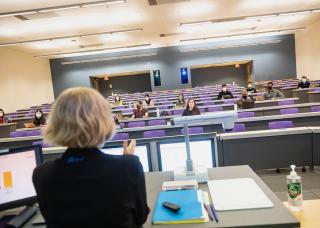
How UBC’s Learning Spaces team is getting ready for a return to campus

This is part six in a series recognizing faculty and staff who are supporting UBC’s transition back to campus. In this update, we showcase the efforts of our colleagues who manage the creation, operation and maintenance of UBC’s learning environment for students and faculty.
Whether learning takes place in a quiet corner of the campus, a laboratory or a 500-seat lecture theatre, each and every one of UBC’s learning spaces is an important part of the campus experience for students and faculty alike. When it comes to teaching, learning, and research, an optimal physical environment is crucial for creating an experience that is engaging, immersive and collaborative. So, what happens when a global pandemic causes a massive shift away from learning in the physical space, to learning in an online/virtual space? What does this shift mean for the teams that manage UBC’s learning spaces, and how are they preparing for a return to campus this fall?
Steven Lee, Learning Space Planner, is one of three key members of UBC Vancouver’s Learning Spaces team, and like many of us, he felt the impacts of this pandemic on his team’s day-to-day function and operations. “We used to spend a significant part of our days on-site managing the university’s physical learning spaces,” says Steven. “We examined everything from paint on the walls, to ceiling tiles, to furniture configuration. We also assessed acoustics, installed instructional technology, and coordinated design enhancements – the next thing we knew, we were working remotely focusing almost exclusively on online learning and COVID-19 safety planning.”
UBC Vancouver’s Learning Spaces team is part of UBC Facilities – they are a small, but mighty trio who are not only responsible for managing formal and informal learning spaces on a day-to-day basis, but are also responsible for annual upgrades, design analysis and future builds. Steven works alongside Leanne Feichtinger, Learning Space Analyst, and Jodi Scott, team lead and Senior Learning Spaces Planner.
At the onset of the pandemic, when things had shifted online, the UBC Vancouver Learning Spaces team saw an urgent need to prepare and equip certain rooms for faculty who needed to be on campus to continue teaching virtually. “Only 10% of our classroom inventory had technology to support teaching virtually,” notes Jodi. “Building and classroom closures meant that we needed to work quickly to facilitate a booking process, safety plans and cleaning routines in time for the upcoming term.”
Initially, the team was able to enable 10 rooms for recording and live streaming, but have now expanded that project to add recording capabilities to over 160 General Teaching Spaces (GTS). Jodi continues, “This represents a significant expansion of this capability which will now be available in approximately 70% of the GTS inventory of rooms – this is the single largest audio visual implementation of this kind, size and magnitude that this campus has ever seen.”
To ensure that faculty and students have access to technology-enriched options, a number of drop-in recording kits and mobile Zoom carts will be available for loan for the remaining learning spaces that do not have the technology built-in.
"This is the single largest audio visual implementation of this kind, size and magnitude that this campus has ever seen.”
Jodi Scott, Team Lead and Senior Learning Spaces Planner, UBC Vancouver
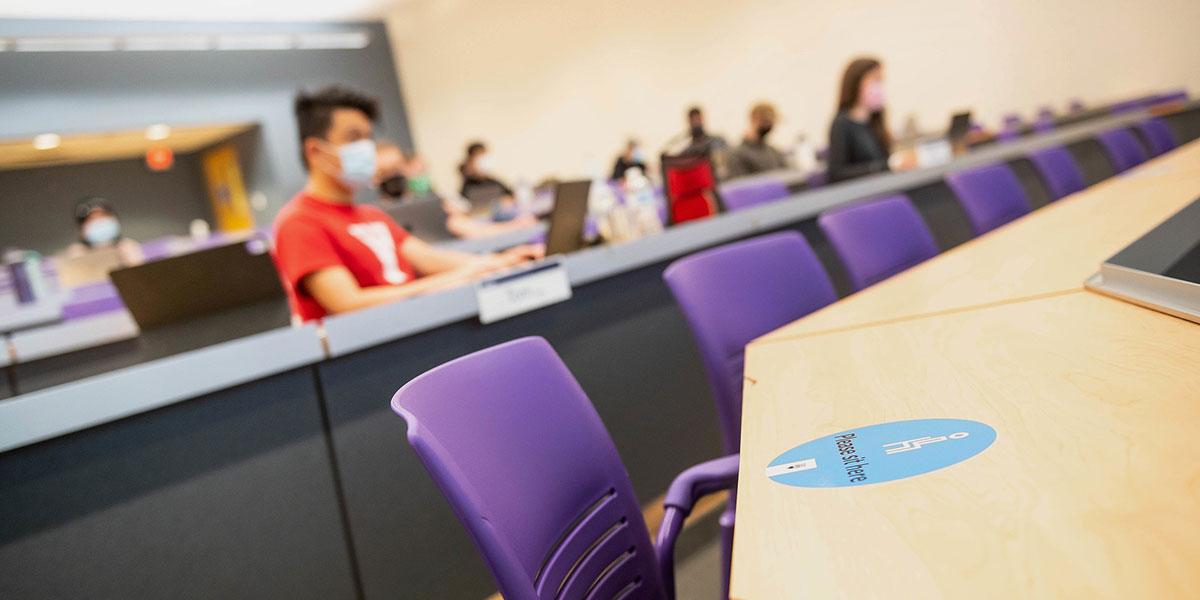
With many of the classrooms or buildings being temporarily closed over the past year, you might assume the need to manage the physical learning spaces on campus would have eased or slowed down, but that was not the case for this dedicated Learning Spaces trio.
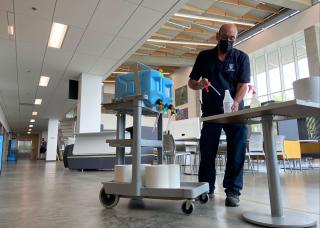
What many people may not realize is that there were many classes taught in person during the pandemic and that meant more than simply setting up a classroom for recording and streaming. Steven and his team worked diligently to ensure that learning spaces were safe and operational. From creating physically distanced furniture layouts and seating capacities, to programming instructor key card access, the team was involved in every detail when it came to helping departments prepare for classroom use.
“In some cases, classrooms were the only spaces occupied in the entire building,” says Steven. “This necessitated a plan to add safety measures to adjacent spaces like hallways, washrooms, elevators, and common areas with physical distancing signage and traffic flow floor decals as well.”
In the Okanagan, learning spaces are a shared responsibility. Last year, when informal learning spaces proved to be areas in high demand, campus stakeholders came together to re-evaluate their room booking system and implement COVID-19 safety plans. In addition, a number of key teams stayed on campus to ensure that students had designated study spaces. “Those teams put a tremendous amount of effort into our learning spaces in order to give students what they needed to succeed,” recalls Adrian Hingston, Associate Director Health, Safety and Environment, UBC Okanagan. “They had a presence in all of these spaces, keeping the self-serve sanitation stations stocked with supplies, monitoring capacity levels, and doing routine cleaning, just to name a few – they kept those spaces safe and operational for all of us.”
Throughout the pandemic, the Learning Spaces team has been working closely with all of UBC’s Faculties, as well as a number of key campus groups, such as Campus Security, UBC IT Audio Visual, Building Operations, Scheduling Services, Custodial Services, the Provost’s Office, and the Learning Spaces Advisory Committee.
Two additional groups that have been instrumental in supporting their efforts are Safety and Risk Services, and the Covid Campus Leadership Advisory Committee. With this added guidance, Steven and his team have created UBC’s Learning Spaces COVID-19 Safety Plan. This plan served to provide a healthy and safe learning environment across the university’s 350 GTS classrooms as well as a template for faculty-controlled classrooms to use.
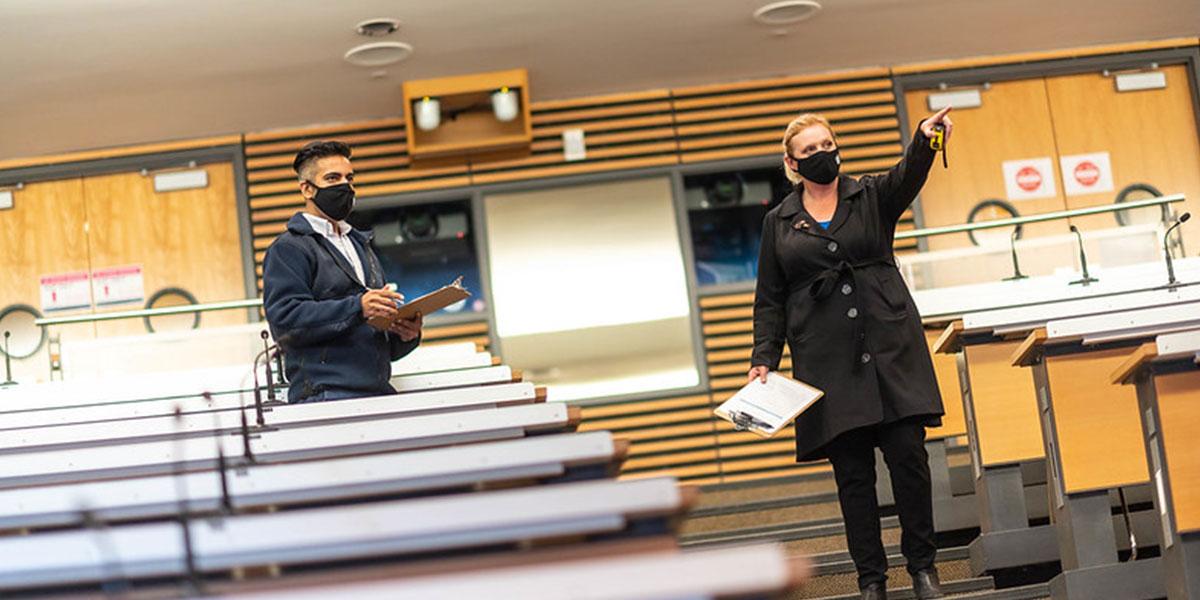
As we approach the fall, the focus has begun to shift back to the physical space. “We’re taking care to ensure that each room is compliant with the requirements of BC’s Restart plan,” says Steven. However, compliance isn’t the only thing on Steven’s radar, “We need all classrooms to be set up and fully equipped in time for in-person learning come September. Someone actually has to go through each room and check every piece of furniture and even every lightbulb!”
Steven and his team have also been working with UBC’s HVAC Working Group to review the building ventilation systems that service learning spaces to ensure a safe indoor environment.
Over at UBC Okanagan, there is also a concerted effort to ensure that informal learning spaces are compliant, in alignment with provincial safety guidelines and – where it makes sense – consistent with actions taken at UBC Vancouver. “We brought a group together for the purposes of the pandemic to manage learning spaces in a consistent way and to make recommendations in terms of campus readiness for the September term,” notes Adrian. “We focused on centralizing services to offer students an enhanced learning experience, while striving to keep everyone safe and happy.”
We need all classrooms to be set up and fully equipped in time for in-person learning come September. Someone actually has to go through each room and check every piece of furniture and even every lightbulb!”
Steven Lee, Learning Space Planner, UBC Vancouver
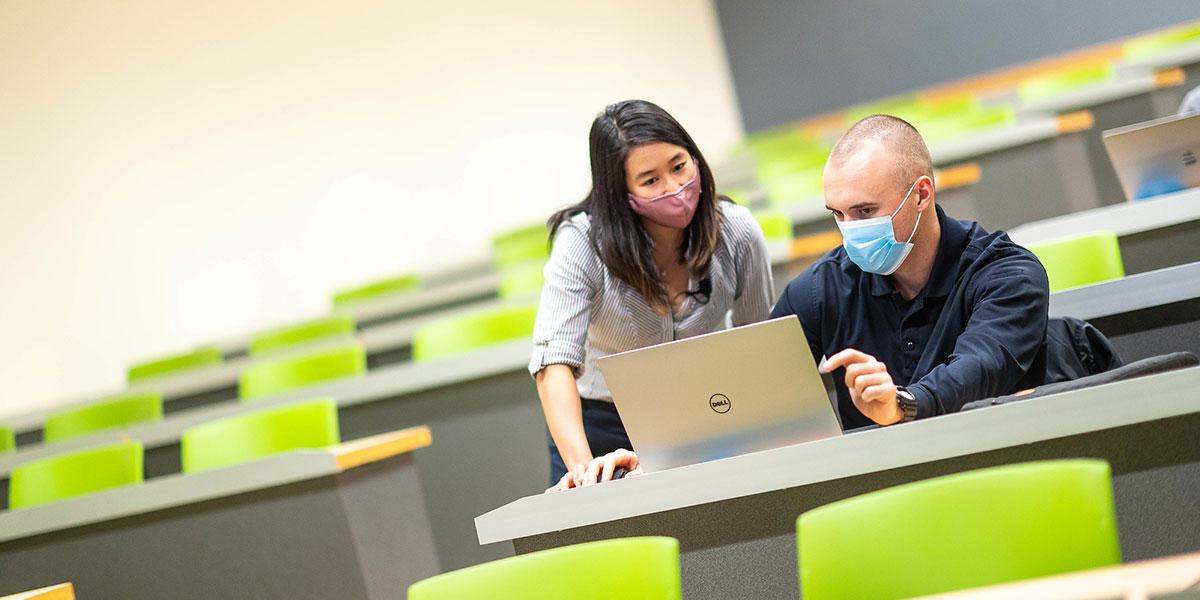
“One thing that has really surprised me is how much tighter we’ve become as a portfolio,” notes Steven. “The Facilities group has always been really dedicated and tight-knit, but the pandemic has pushed all departments to step up and collaborate in a more impactful way. We wouldn’t be the group we are today without everyone’s dedicated efforts.”
Written by Rivka Parris, UBC Internal Communications
August 2021
"We focused on centralizing services to offer students an enhanced learning experience, while striving to keep everyone safe and happy.”
Adrian Hingston, Associate Director Health, Safety and Environment, UBC Okanagan
The Learning Spaces team supports the creation, operation and stewardship of UBC’s learning environment for students and faculty members. To learn more about UBC’s Learning Spaces, including latest updates, a list of capable rooms and functionality, detailed descriptions and videos of the available solutions, or for information related to booking recordings or AV support, visit https://learningspaces.ubc.ca/
Find the latest news, updates, events, and useful dates from across UBC, curated for faculty and staff by Internal Communications.
Access a library of resources from multiple UBC websites, all in one place.